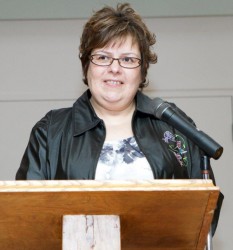Article Origin
Volume
Issue
Year
“I know what it takes for a person to stand up and be alone,” said Jack Frimeth, founder and organizer of the Aboriginal Heritage Festival held annually in Fergus, Ont. Addressing the audience at the Wellington County Museum on April 20, Frimeth said, “We felt that Chief Theresa Spence took that stand and by herself,” Frimeth said.
Inspired by the Idle No More movement, the festival committee decided to establish an Aboriginal Heritage Award “to be presented to an Aboriginal person who has exhibited achievement and accomplishment beyond that which would normally be expected towards the benefit of Aboriginal people.”
Frimeth announced Chief Theresa Spence of Attawapiskat as the first recipient of the award.
“For 44 days [during her famous fast] starting in December, Chief Theresa Spence was the face of Idle No More,” he said. She “galvanized that whole movement.”
Along with his colleague Naomi Smith, Frimeth visited Chief Spence at Victoria Island during her fast and felt the energy, the power, unity and brotherhood amongst those gathered there.
“Everyone felt as one,” Frimeth said, “and there was one person who made all that possible, that made it all happen and that was Chief Theresa Spence.”
His group chose to ignore the negative media reports.
“I don’t know what’s true, what’s not true,” he said. “I don’t live in Attawapiskat. I can’t tell you what’s going on there.” Chief Spence’s actions spoke louder and truer than any of the controversy and negativity.
As Spence rose and made her way to the podium to give the keynote address, the hundred or so people gathered rose to their feet and greeted her with thunderous applause. Spence introduced herself in Cree and with her spirit name, “she who speaks the truth”. The handful of speaking notes she had were soon abandoned and she told the audience she preferred to speak from the heart.
“You can’t eat diamonds or drink oil,” she said, as she urged people to protect the land. “The land is our way of life,” she said. Directing her remarks particularly to the Cub Scouts sitting in the front row, “It’s your way of life too. You use the land just as much as we do but you use it in a different way.”
She said people have to work together; that the struggle is not just about First Nations anymore. It’s about Canadian citizens too. Mother Earth is giving people signals. She’s being disturbed too much, said Spence. She commented on the farmland she’d seen in the area and said the farmers too must have environmental concerns.
Spence gave a quick lesson on what being a chief was all about. Twenty-four hour days, seven days a week, phone ringing in the middle of the night, and dealing with any and all crises involving community members, government or the mining company.
For example, she said, DeBeers has launched a lawsuit against Attawapiskat community members. Spence went to court even though DeBeers told her the dispute was not with the leadership.
“This is what they don’t understand,” she said. “They expect the leadership to abandon or neglect their people…. As a chief, I have to be there to protect them and stand by them.”
Talking about her fast at Victoria Island in Ottawa during the winter, Spence spoke about the power of prayer. On a day she felt especially alone, even though she was surrounded by people, she went to the river by the Parliament Buildings to pray and tell the Creator she couldn’t continue alone. Shortly after, two men arrived to fast with her—Jean Socks from New Brunswick, and Manitoba elder and former Chief Raymond Robinson.
One of the subjects she discussed with Robinson, who became like a brother to her, was how the government controls First Nations with the Indian Act.
“We have to have a different way,” she said, “because the Indian Act, it’s not working. It’s never gonna work…you don’t feel like a person.” She encouraged Canadians to learn about First Nations history, especially about the treaties.
“Once you understand the treaty,” she said, “you will respect us. We will respect each other because it’s about partnership. It’s supposed to be teamwork, not one-sided.”
Following her talk, a long line-up of people waited to congratulate Spence and to have their photo taken with her.
- 4078 views

